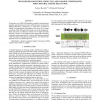Free Online Productivity Tools
i2Speak
i2Symbol
i2OCR
iTex2Img
iWeb2Print
iWeb2Shot
i2Type
iPdf2Split
iPdf2Merge
i2Bopomofo
i2Arabic
i2Style
i2Image
i2PDF
iLatex2Rtf
Sci2ools
ICASSP
2009
IEEE
2009
IEEE
Speaker recognition using syllable-based constraints for cepstral frame selection
We describe a new GMM-UBM speaker recognition system that uses standard cepstral features, but selects different frames of speech for different subsystems. Subsystems, or “constraints”, are based on syllable-level information and combined at the score level. Results on both the NIST 2006 and 2008 test data sets for the English telephone train and test condition reveal that a set of eight constraints performs extremely well, resulting in better performance than other commonly-used cepstral models. Given the still largely-unexplored world of possible constraints and combinations, it is likely that the approach can be even further improved.
Commonly-used Cepstral Models | GMM-UBM Speaker Recognition | ICASSP 2009 | Signal Processing | Standard Cepstral Features |
| Added | 21 May 2010 |
| Updated | 21 May 2010 |
| Type | Conference |
| Year | 2009 |
| Where | ICASSP |
| Authors | Tobias Bocklet, Elizabeth Shriberg |
Comments (0)

